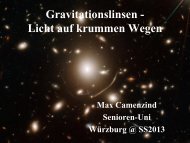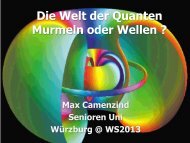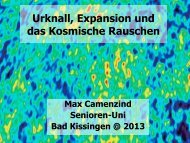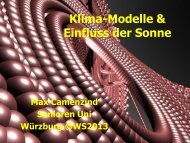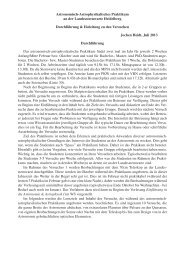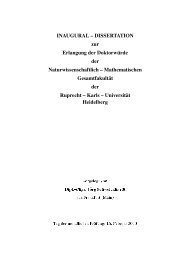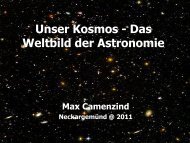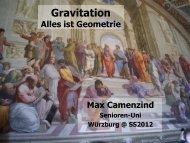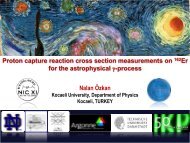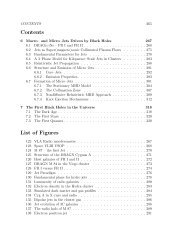QUASARs and Rotating Black Holes - Landessternwarte Heidelberg ...
QUASARs and Rotating Black Holes - Landessternwarte Heidelberg ...
QUASARs and Rotating Black Holes - Landessternwarte Heidelberg ...
Create successful ePaper yourself
Turn your PDF publications into a flip-book with our unique Google optimized e-Paper software.
<strong>QUASARs</strong><br />
<strong>and</strong><br />
<strong>Rotating</strong> <strong>Black</strong> <strong>Holes</strong><br />
Max Camenzind<br />
L<strong>and</strong>essternwarte Königstuhl<br />
<strong>Heidelberg</strong> 2002
Contents<br />
• Quasars as cosmological objects<br />
Æ pre-Quasar era: 1908 – 1960<br />
Æ Quasar era: 1963 – 2000<br />
Æ post-Quasar era: 2000 - ….. (> 100 000)<br />
• Quasars are broad b<strong>and</strong> emitters<br />
Æ accretion, dust <strong>and</strong> hot ion tori !<br />
• Models for Quasars: > 8 parameters !<br />
Æ r < 100 pc in Spirals, r < 1 kpc in Es/S0s<br />
• Quasar search: 2dF, SDSS, ….<br />
• Jetty Quasars: interesting minority …
5 Lectures on Quasars<br />
• Active Quasars: definition, taxonomy, history,<br />
spectra <strong>and</strong> global models Æ Friedmanology;<br />
• Quasar Remnants: Remnants in centers of<br />
galaxies, correlations, galaxy types, examples<br />
Æ Spheroidal structure of galaxies;<br />
• Jetty Quasars: Jets <strong>and</strong> radio galaxies, jet<br />
speeds, plasma, synchrotron <strong>and</strong> IC emission<br />
Æ Kerr <strong>Black</strong> Hole at the very center;<br />
• Hidden Quasars: Type I <strong>and</strong> II, dust, X-rays;<br />
• Early Quasars: from the first stars to z=5<br />
Æ <strong>Black</strong> <strong>Holes</strong> <strong>and</strong> Gamma-Ray Bursters
Astronomical Object Type<br />
• Quasar st<strong>and</strong>s nowadays as a synonyme for Active<br />
Galactic Nuclei Æ Galaxies are „dead Quasars“;<br />
• Æ central activity in a galaxy not related to stars:<br />
• (i) Luminous UV-emission from a compact core in<br />
the nucleus of the galaxy – in quasars only the core<br />
is visible (stellar like appearance) Æ UV Excess<br />
• (ii) strongly broadened emission lines Æ Surveys<br />
• (iii) time variability (> hours);<br />
• (iv) compact radio core (Sag A*);<br />
• (v) X-ray, gamma-ray <strong>and</strong> TeV emission.<br />
• In bright quasars, the radiation from a region<br />
comparable to the solar system is several hundred<br />
times brighter than the galaxy emission.
Pre-Quasar Era<br />
• 1908: emission lines from NGC 1068 (E. Fath,<br />
Lick Obs.; V.M. Slipher, Lowell);<br />
• 1913: detection of the „jet“ in M 87 (Curtis);<br />
• 1916: Schwarzschild metric – but no astronomical<br />
relevance seen at that time !<br />
• 1926: Andromeda is extragalactic, <strong>and</strong><br />
1930: Universe of galaxies exp<strong>and</strong>s (Hubble) –<br />
but not aware of Friedman solution !<br />
• 1943: new examples of emission line galaxies<br />
(Carl Seyfert) Æ Seyfert galaxies: NGC 4151,<br />
NGC 4051, NGC 1275, NGC 3516, NGC 7469;<br />
• 1959: Seyfert activity takes about 100 Mio years<br />
(Woltjer), since 1% of all spirals are active.
Messier 87<br />
1913 – 2002<br />
Anatomy of a<br />
Dead Quasar
Radio Surveys Æ Quasar Era<br />
• 3CR catalog (178 MHz, Bennett 1961) down to<br />
a limiting flux of 9 Jy (1 Jy = 10 -26 W m -2 Hz -1 );<br />
• PKS survey on the southern hemisphere (408<br />
MHz, Ekers 1969) down to 4 Jy; later at 1410<br />
MHz (1 Jy) <strong>and</strong> 2650 MHz (0.3 Jy);<br />
• More sensitive 4C survey down to 1 Jy (1965);<br />
• Ohio survey: very luminous sources (OH 471);<br />
• 3C 48, 3C 273 first identified sources (1963).<br />
• Later it turned out that only a minority is RL !
The quasar 3C 273
SDSS<br />
z = 0.2<br />
SDSS<br />
z = 0.5
SDSS<br />
z = 2.05<br />
SDSS<br />
z = 4.96
High<br />
Redshift<br />
Quasars<br />
(SDSS,<br />
NGST)
Historical Interlude<br />
• 1963: Maarten Schmidt 3C 48, 3C 273;<br />
• 1963: Roy Kerr finds <strong>Black</strong> Hole solution (PRL) !<br />
• 1960s – 1970s: hundreds of QSOs detected;<br />
• 1978: Einstein Observatory launched by NASA –<br />
first imaging X-ray satellite<br />
Æ Seyfert galaxies <strong>and</strong> QSOs are X emitters;<br />
• Æ 2002 Nobel Prize: R. Giacconi;<br />
• 1980s: Radio galaxies <strong>and</strong> Quasars are mapped<br />
with VLA <strong>and</strong> MERLIN Æ DRAGN Homepage !<br />
• 1990s: Compton Gamma Ray Observatory<br />
Æ some Quasars are high energy emitters.<br />
• > 1990: <strong>Black</strong> Hole Remnants are detected in<br />
nearby galaxies: M 87, M 31, Sag A*, … Æ ~ 40<br />
• 2001: Highest redshift for a Quasar: z = 6.25
Global Continua of Quasars<br />
• Energetisation by accretion from the parsecscale<br />
onto the central <strong>Black</strong> Hole, emitted<br />
mainly in the optical-UV-sX spectral region;<br />
• Thermal emission from dust distributed on<br />
the scale from a few parsecs to hundreds of<br />
parsecs in the bulge of the host galaxies,<br />
emitted at wavelengths from 500 µm to a few<br />
µm (ISO data for bright PG Quasars, see<br />
Haas et al. 2000, A&A 354, 453; 2002);<br />
• Hard X-emission from the inner torus around<br />
the <strong>Black</strong> Hole (ASCA, Ch<strong>and</strong>ra, XMM).
X-Rays
------- ~ 10 pc -------- >
<strong>Black</strong> Hole<br />
Paradigm<br />
Popular Model, but wrong !<br />
Å pc Æ
My favourite<br />
Quasar<br />
Model<br />
Å kpc Æ<br />
giant Elliptical<br />
Dust heated<br />
by central Quasar<br />
M_H = 10^9 M_S<br />
Scattered UV light
Parameters of Quasars<br />
• Mass <strong>and</strong> Radius of central stellar Bulge<br />
(radii < 1 kpc);<br />
• Mass <strong>and</strong> velocity profiles of gas <strong>and</strong> dust in<br />
Bulge (turbulent + rotation);<br />
• Mass of <strong>Black</strong> Hole M H;<br />
• Angular momentum of <strong>Black</strong> Hole J H;<br />
• Accretion rate towards <strong>Black</strong> Hole<br />
Æ Relative accretion modulo mass important;<br />
• Inclination angle with respect to line of sight;<br />
• Magnetic fields in Bulge region.<br />
• Æ Relative accretion rate determines the<br />
physical state of the bulge !
Quasar Samples<br />
• Luminous Quasars (PG) at low redshifts,<br />
120 m_B < 16 (Schmidt & Green 1983)<br />
with known radio, X-ray (ASCA), IR (IRAS,<br />
ISO) properties.<br />
• Hewitt & Burbidge (1993): m_B < 18<br />
Æ 7236 Quasars with known redshifts;<br />
• 2dF Quasar Survey (AAT): m_B < 21;<br />
2 strips 75° x 5° Æ 25‘000 Quasars<br />
expected (2002: 23‘000);<br />
• SDSS (ongoing): m_B < 22 Æ 100‘000<br />
Quasars; Æ highest redshifts z = 6.2 !
erg / s]<br />
46<br />
L_f [10<br />
1<br />
10 -1<br />
10 -2<br />
10 -3<br />
10 -4<br />
10 12<br />
10 13<br />
ISO-PHOT - Optical<br />
10 14<br />
10 15<br />
1634+706<br />
1206+459<br />
1302-102<br />
1613+658<br />
10 16<br />
f [Hz]
Mass Estimates<br />
• (i) Eddington mass (lower limit): L acc < L Edd<br />
Æ M Q > M Edd = L Edd / 0.1*c² .<br />
• Æ M Q > 10 9 M S for bright quasars;<br />
• Æ M Q > few Mio solar masses for Seyferts;<br />
• (ii) Spectral mass: UVX-bump;<br />
• (iii) Virial mass: M Q = f*R_BLR*sigma²/G;<br />
R BLR = c*tau; sigma Å V FWHM of BLR;<br />
• Growth time under Eddington accretion:<br />
• t Ed = 40 Mio yrs (independent of mass).<br />
Æ exp(20) = 480 Mio<br />
Æ BH can grow in 500 Mio yrs to 10 9 M S !
Peterson 2000
No local<br />
Quasars !
SDSS<br />
Quasars<br />
• Preliminary<br />
analysis:<br />
• 2625 QSOs<br />
• 529 deg²<br />
• Slice 2.5 deg
2dF 2001
Result<br />
• Quasars evolve in<br />
• (i) space density;<br />
• (ii) intrinsic luminosity Æ quasars at higher<br />
redshifts are more luminous.<br />
• Æ High redshift quasars are hosted by<br />
massive galaxies (ellipticals) !<br />
• Æ Large samples of quasars which must<br />
be investigated in UVX-bump, HX-ray,<br />
radio <strong>and</strong> IR properties !<br />
• Æ Cosmological consequences: clustering<br />
as a function of redshift.
Jetty Quasars<br />
• One Jansky Catalog Æ Radio Galaxies<br />
<strong>and</strong> Quasars.<br />
• Structure of 3C sources<br />
• Æ FR II sources<br />
• Æ FR I sources<br />
• Continua of RL Quasars: jet emission<br />
• Æ High redshift radio galaxies
3C 273
Jetty<br />
Quasar



